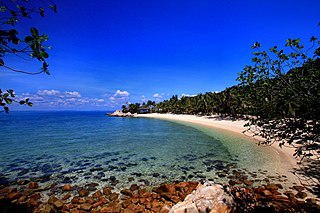
Tioman Island is 32 kilometres off the east coast of Rompin District, Pahang, Malaysia. It is 39 kilometres long and 12 kilometres wide and has seven villages, the largest and most populous being Kampung Tekek on the central western coast. The densely forested island is sparsely inhabited, and is surrounded by numerous coral reefs, making it a popular scuba diving, snorkelling, and surfing spot. There are many resorts and chalets for tourists around the island, which has duty-free status.

Natuna Regency is an islands regency located in the northernmost part of the Province of Riau Islands, Indonesia. It contains at least 154 islands, of which 127 of them are reported as uninhabited. This archipelago, with a land area of 1,978.49 km2 out of a total area of 264,198.37 km2 area, This area is divided into island clusters such as the Natuna Island Cluster and the Serasan Island Cluster. However, several other islands that are not located in the two clusters are spread over a wider area. This division reflects the geographical and administrative location of the district, but there are also other small islands that are outside these two main clusters and are not always included in the grouping. Administratively, this area is divided into 17 districts (kecamatan) which function to facilitate management and services for the local community and support the development of the potential of the region which is rich in natural resources and tourism. This regency also plays an important role in maintaining Indonesia's sovereignty in the northern border area.

The Perhentian Islands are a group of islands off the coast of Besut District, Terengganu, Malaysia.

Redang Island is an island in Kuala Nerus District, Terengganu, Malaysia. It is one of the largest islands off the east coast of Peninsular Malaysia and one of the most beautiful islands in the world. It is famous for its crystal clear waters and white sandy beaches. It is one of nine islands that made up an eponymous marine sanctuary park offering snorkeling and diving opportunities for tourists.
Tinggi Island is an island in Mersing District, Johor, Malaysia.

Rawa Island is a coral island in Mersing District, Johor, Malaysia. Nearby islands include Harimau and Mensirip.

Sibu Island is an island off the coast of Mersing District, Johor, Malaysia. It was declared as a marine park in 1993.

Tengah Island, also known as Babi Tengah Island, is a privately owned island in the Mersing District of Johor, Malaysia, located approximately nine nautical miles off the coast of Mersing in the South China Sea. The island covers an area of about 0.54 km2
Pemanggil Island is an island in Mersing District, Johor, Malaysia.

Mersing is a town, mukim and the capital of Mersing District, Johor, Malaysia. The town is located at the southern end of the east coast of Peninsular Malaysia. As of 2010, the town has an estimated population of 70,894.
The state of Johor in Malaysia is noted for its national parks and forest reserves which preserve virgin rainforests known for its biodiversity and endangered species of animals. Mangrove swamps and coral reefs are also protected within these parks.
Teluk Mahkota is a bay and tourism attraction in Sedili, Kota Tinggi District, Johor, Malaysia.

The Sedili Besar River is a river in Kota Tinggi District, Johor, Malaysia.

Mersing District is one of the 10 districts district in Johor, Malaysia. Its seat is located at Mersing Town.

The Aur Island is an island in Mersing District, Johor, Malaysia. It lies about 76 kilometres (47 mi) east of Mersing Town and is part of the Johor Marine Park. Its corals, lagoons and offshore pools make it a tourist attraction. It has for many years also been a frequent stopover point for fishermen.
Harimau Island is an island in Mersing District, Johor, Malaysia. It is one of the 11 islands of the Babi Island chain.
Babi Island or Pulau Babi may refer to:

Orang Seletar are one of the 18 Orang Asli ethnic groups in Malaysia. They are classified under the Proto-Malay people group, which forms the three major people group of the Orang Asli. The Orang Seletar are also considered as part of the Orang Laut, natives of the Straits of Johor; separating Singapore from Peninsula Malaysia.

Kuala Nerus is a district in Terengganu, Malaysia. It is the youngest district in the state, having been declared a separate district in 2014. Formerly it was part of Kuala Terengganu district but the district is still governed by Kuala Terengganu City Council (MBKT) which is one of few city councils in Malaysia to govern two separate districts. Its capital is Kuala Nerus town, other major towns and villages include Gong Badak, Seberang Takir, Batu Rakit and Batu Enam, all which are located within city limits of Kuala Terengganu. Kuala Nerus' population is 226,177 people as of 2015 which makes it the most populous district in Terengganu. The district has a total land area of 397.52 km2.
Dayang Island is an island in Mersing District, Johor, Malaysia. It is one of the three islands of the Aur Island chain. The name of the neighbouring island, Aur Island, means "bamboo island" in Malay and both islands have been known to Chinese sailors for centuries. A map from the 17th century identified them as East and West Bamboo islands.
















